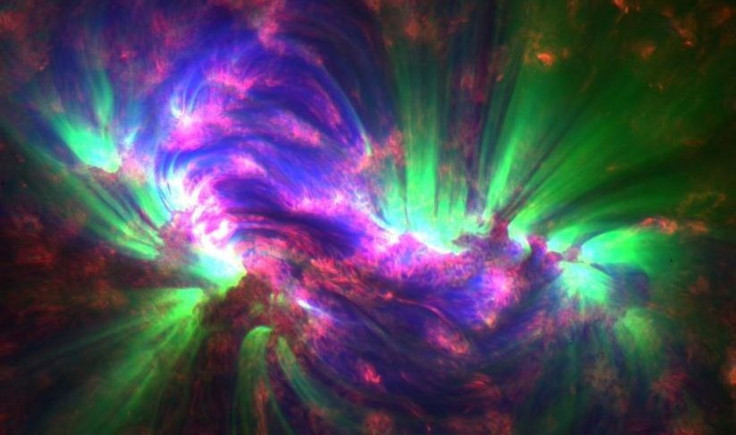Mighty Magnetic Waves Reveal Amazing Power to Heat the Sun's Corona: Study

Scientists have taken a step closer to identifying the power source for the extremely hot corona of the sun and the high speed of the solar wind.
It's a well known fact that the sun's outer atmosphere, or corona, is 20 times hotter than its surface, and the solar wind gets accelerated up to 1.5 million miles per hour. But the source of required energy for these phenomena has long been mystery for scientists.
The exit for the mystery tunnel is near. An international team of scientists has recently discovered strong evidence to suggest powerful magnetic filed ripples, called Alfven waves, heat up the sun's corona more fiercely than previously thought.
NASA's Solar Dynamics Observatory (SDO) satellite allowed them to trace the movements of the seaweed-like material around the sun, and measure the amount of energy carried by the Alfven waves.
Alfvén waves are actually quite simple. They are waves that move up and down on a magnetic field line just like a wave moves along a plucking string.
The sun is surrounded by electrified gas called plasma, which moves in harmony with magnetic fields. Not only do the waves carry unexpected amount of high energy, the energy is possibly enough to drive the two solar phenomena: the intense heating of the corona and hyper fast solar winds.
SDO is able to track the Alfvén waves with its special eyes.
"SDO has amazing resolution so you can actually see individual waves," said Scott McIntosh at the National Center for Atmospheric Research in Boulder, Colo. "Now we can see that instead of these waves having about 1000th the energy needed as we previously thought, it has the equivalent of about 1100W light bulb for every 11 square feet of the sun's surface, which is enough to heat the sun's atmosphere and drive the solar wind."
Alfven waves were directly observed for the first time in 2007 in the chromospheres. The observations showed amplitudes on the order of about 1,600 feet (0.5 kilometers) per second, far too small to heat the corona to its high levels or to drive the solar wind.
The latest study revealed that the original numbers may have been underestimated.
In the research codenamed "The Wiggles," McIntosh and his colleagues tracked the motions of the wiggly material known as spicules spewing up as well as the degree of the spicules swaying back and forth.
Further, the shape, speed and energy of the waves were measured.
It turns out that Alfven waves are over a hundred times stronger than previously measured, with amplitudes on the order of 12 miles (20 km) per second-enough to heat the Sun's outer atmosphere to millions of degrees and drive the solar wind. The waves are easily seen in high-resolution images of the outer atmosphere as they cause high-speed jets of hot material, called spicules, to sway.
"Knowing there may be enough energy in the waves is only one half of the problem," says Vladimir Airapetian at NASA's Goddard Space Flight Center in Greenbelt, Md.
"The next question is to find out what fraction of that energy is converted into heat. It could be all of it, or it could be 20 percent of it - so we need to know the details of that conversion."
It also remains uncertan how the magnetic waves of the sun transfer their energy to the matter in the corona to heat or accelerate it, according to SPACE.com.
Moreover, the waves observed did not appear sufficient to account for the intense emissions of radiation from more-energetic regions of the corona. "We have work left to do with active regions," McIntosh said.
The research was published in a Nature article in the July 28 issue.
© Copyright IBTimes 2025. All rights reserved.





















